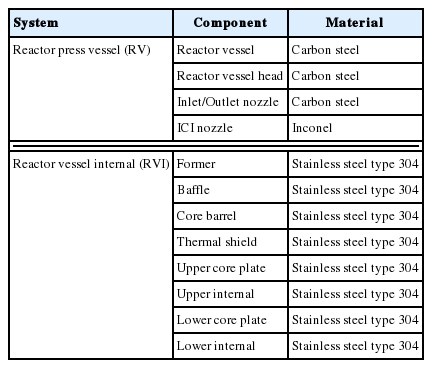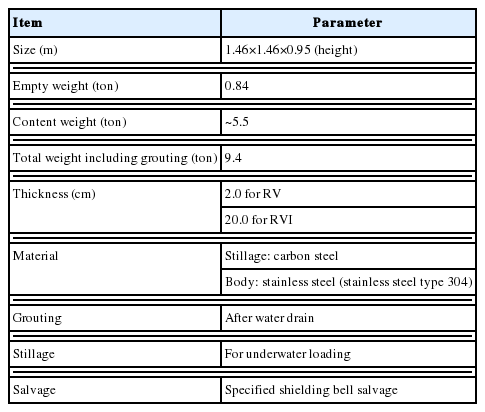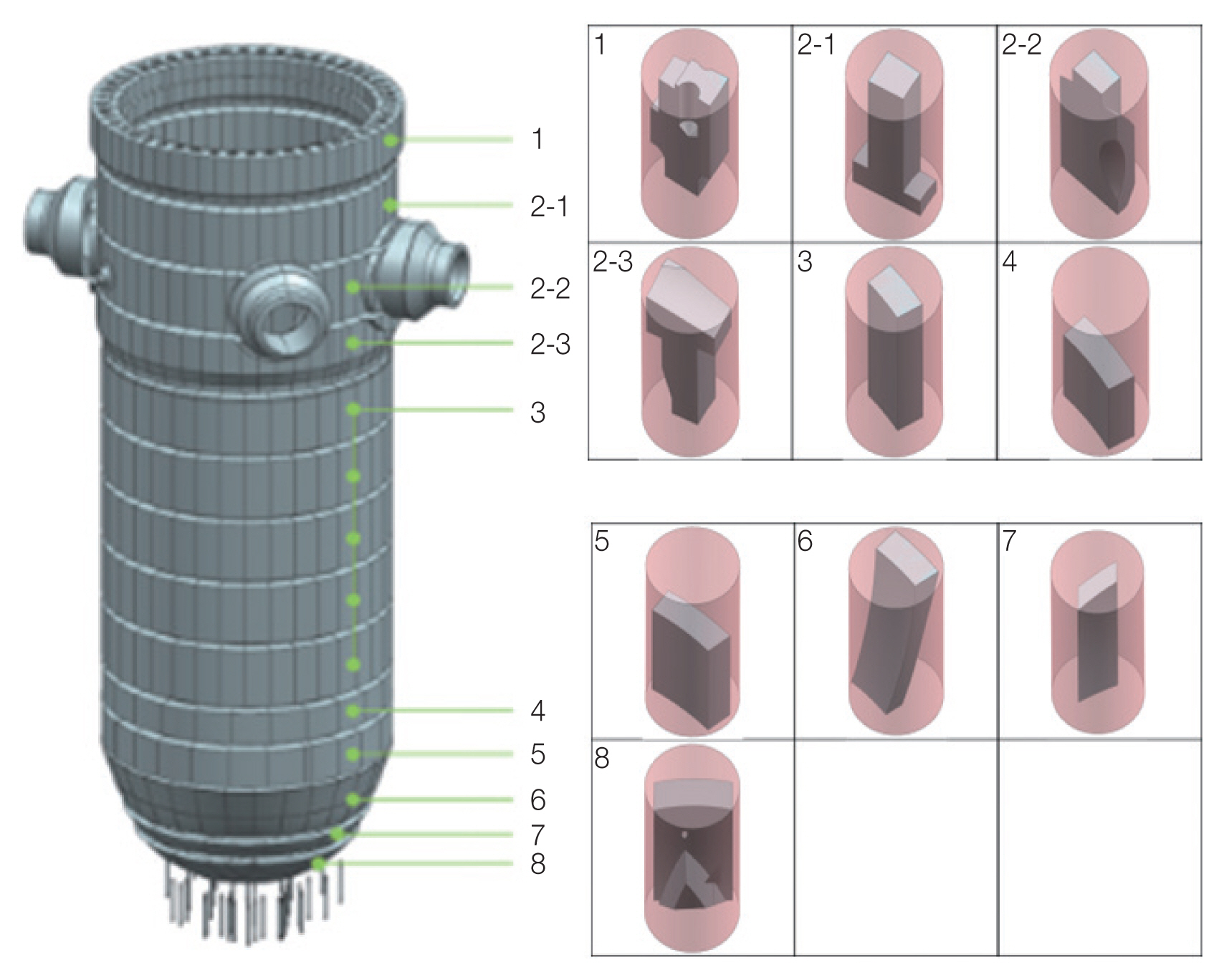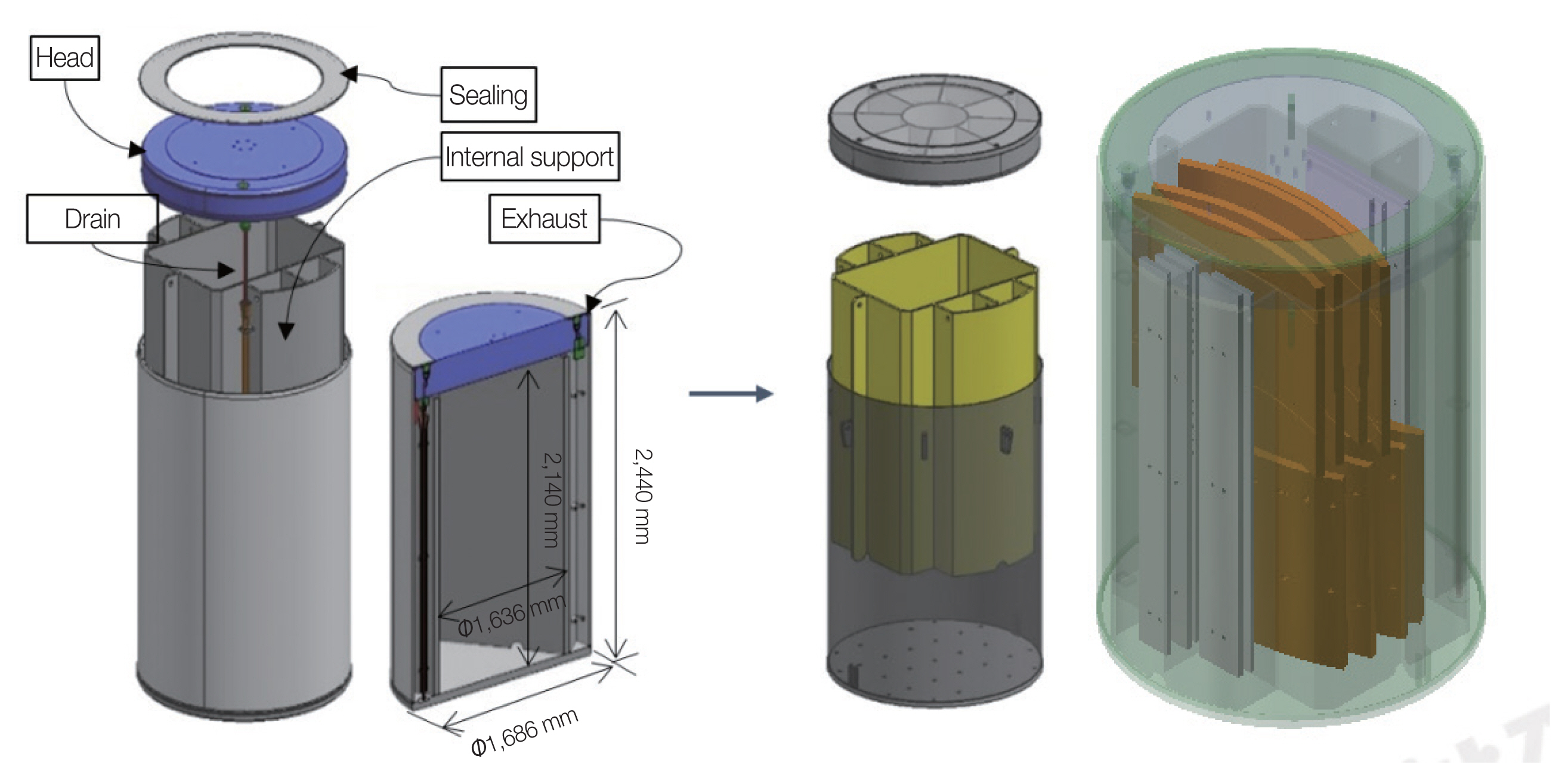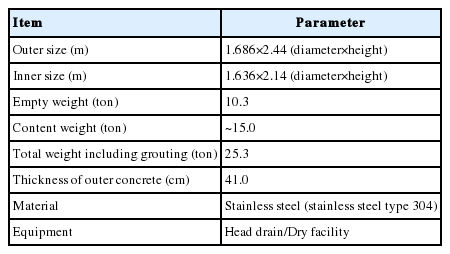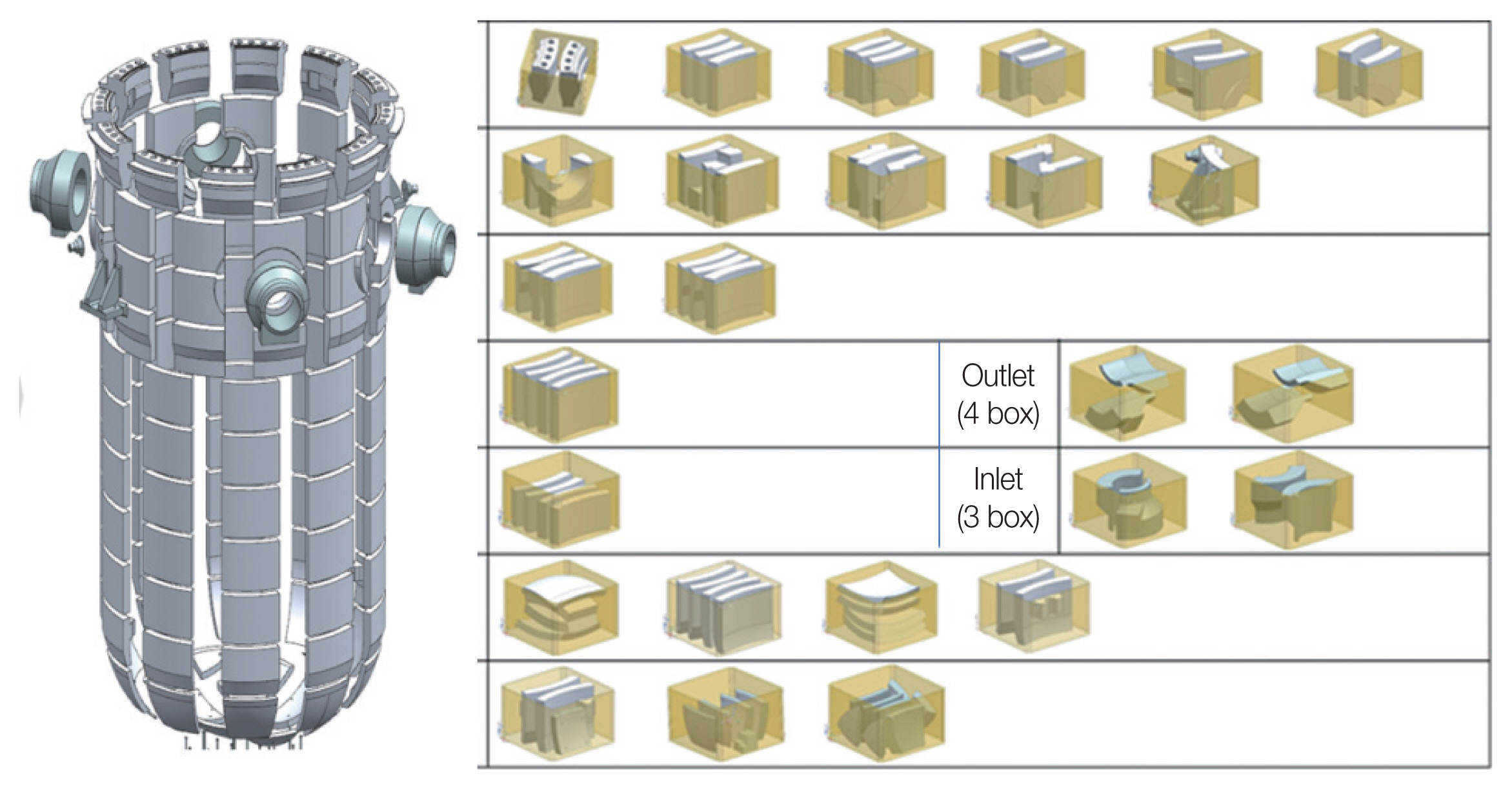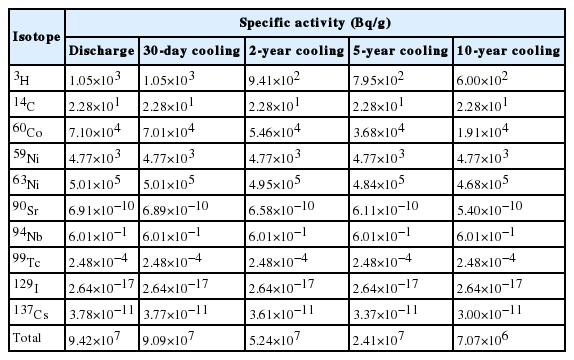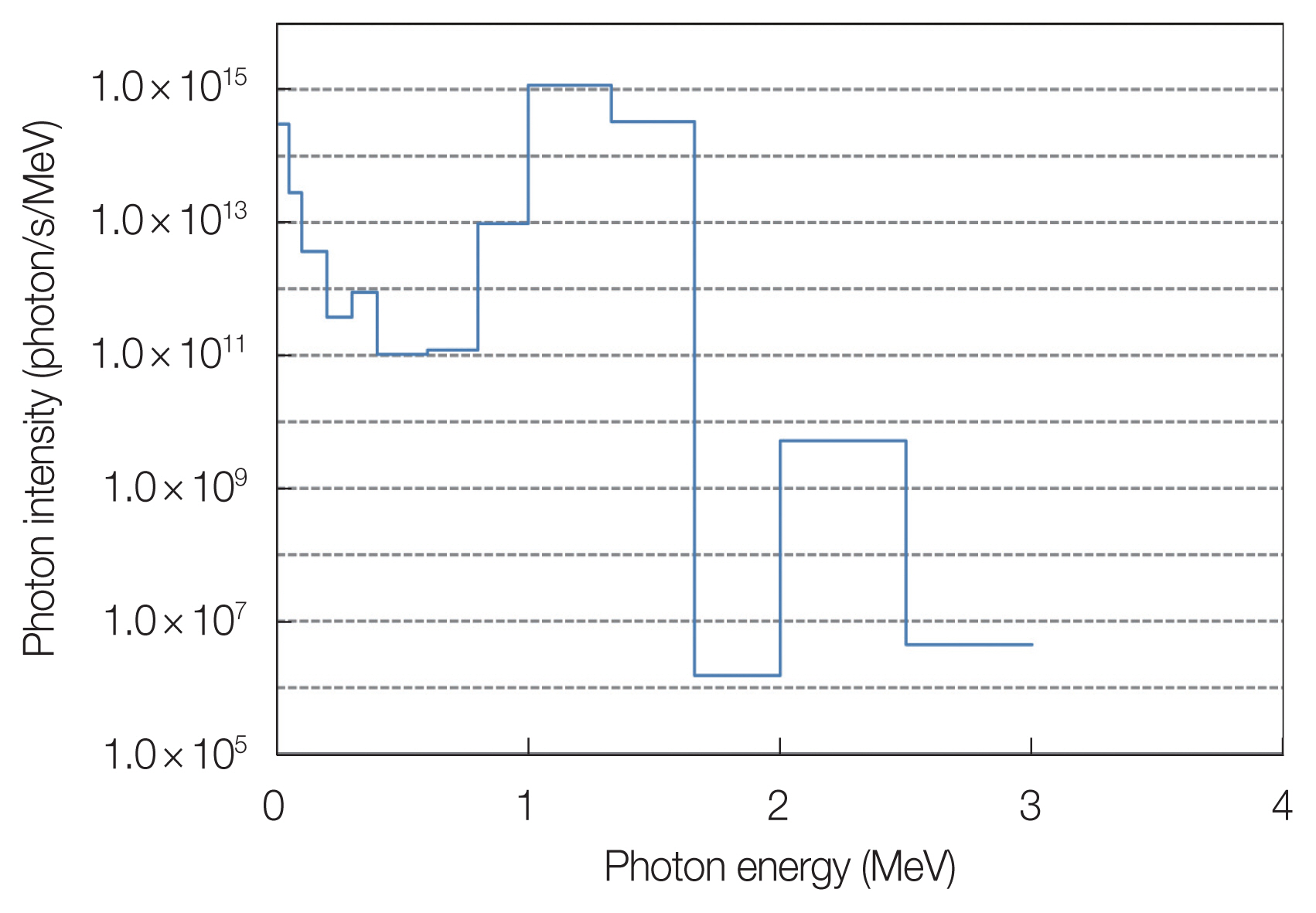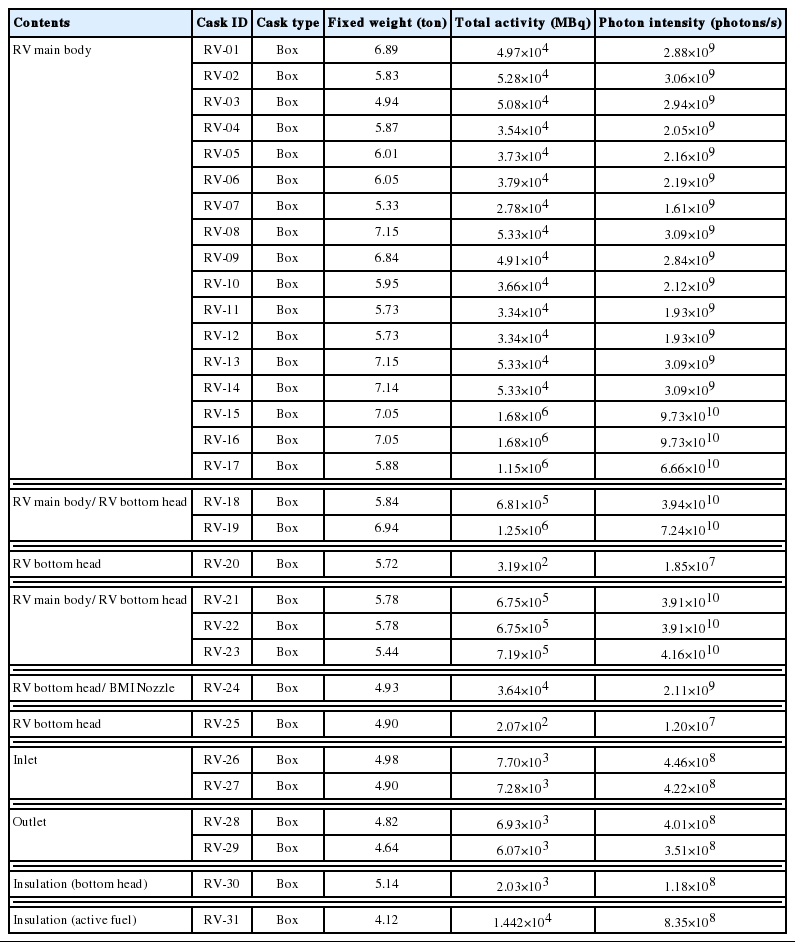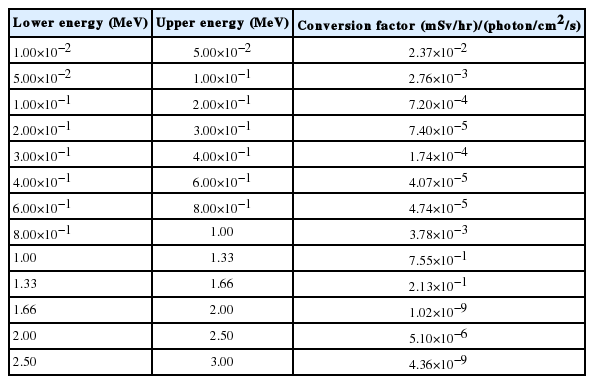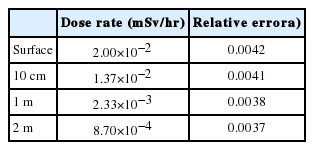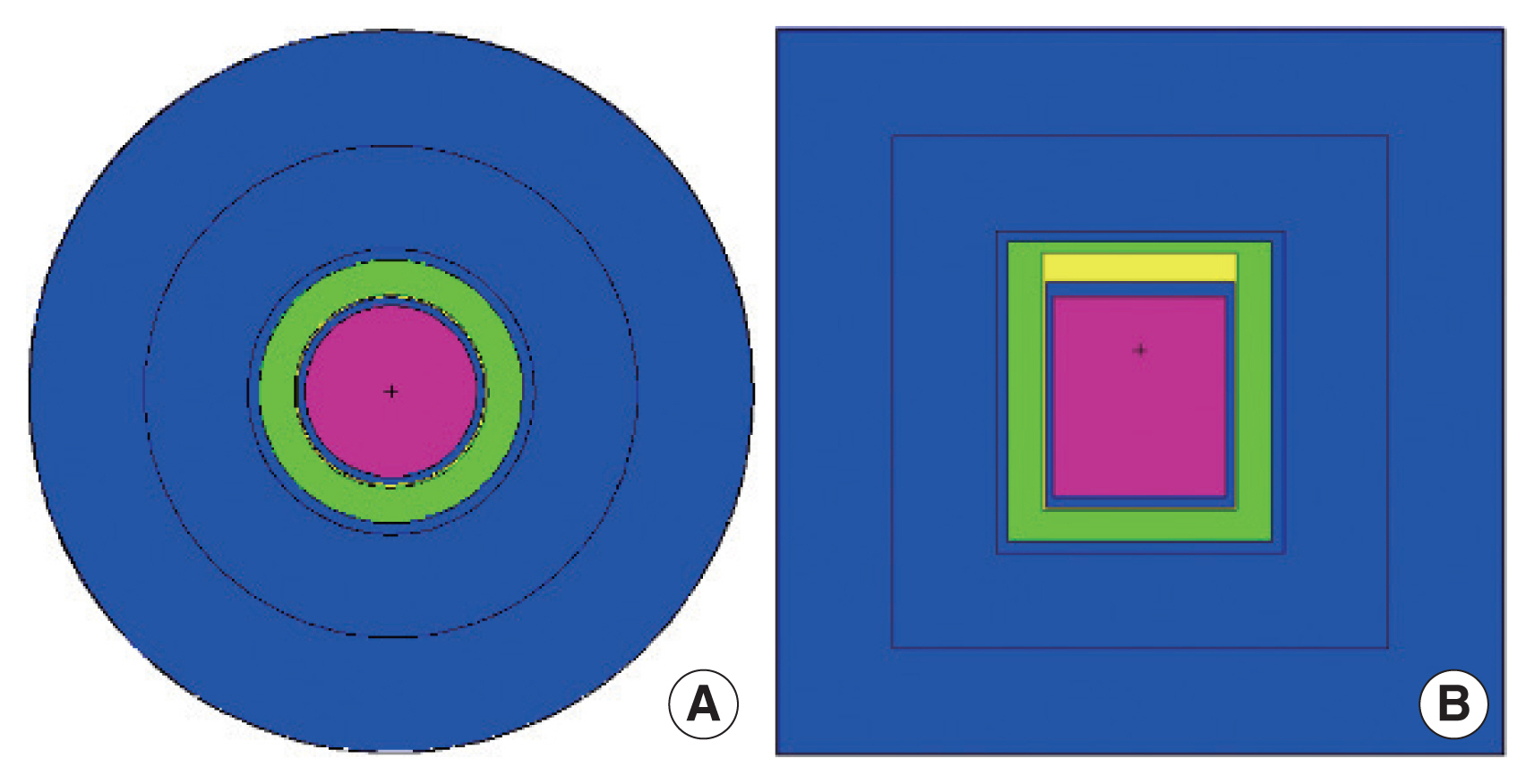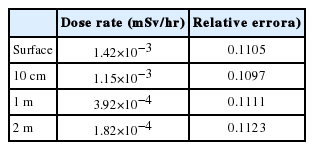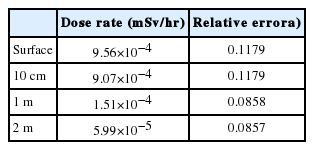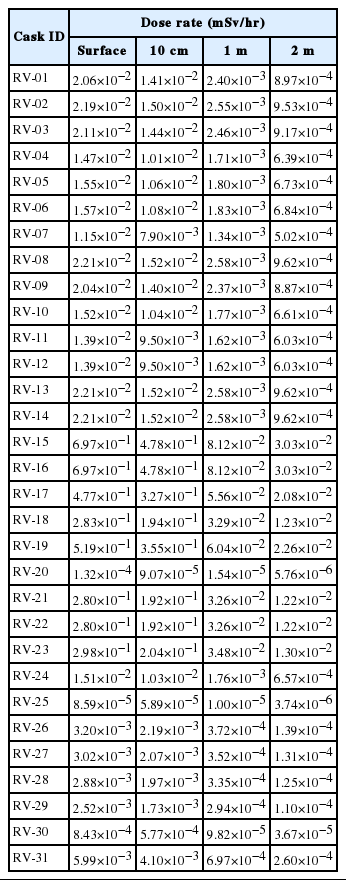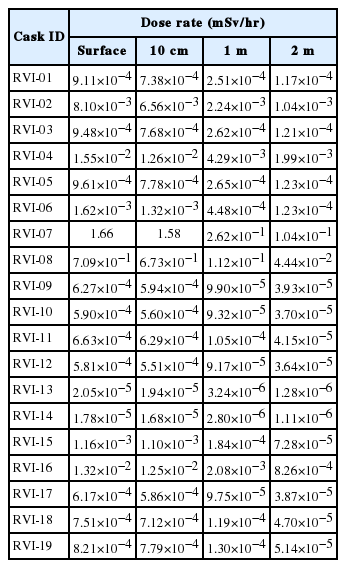Study on Dose Rate on the Surface of Cask Packed with Activated Cut-off Pieces from Decommissioned Nuclear Power Plant
Article information
Abstract
Background
Reactor pressure vessel (RV) with internals (RVI) are activated structures by neutron irradiation and volume contaminated wastes. Thus, to develop safe and optimized disposal plan for them at a disposal site, it is important to perform exact activation calculation and evaluate the dose rate on the surface of casks which contain cut-off pieces.
Materials and Methods
RV and RVI are subjected to neutron activation calculation via Monte Carlo methodology with MCNP6 and ORIGEN-S program—neutron flux, isotopic specific activity, and gamma spectrum calculation on each component of RV and RVI, and dose rate evaluation with MCNP6.
Results and Discussion
Through neutron activation analysis, dose rate is evaluated for the casks containing cut-off pieces produced from decommissioned RV and RVI. For RV cut-off ones, the highest value of dose rate on the surface of cask is 6.97×10−1 mSv/hr and 2 m from it is 3.03×10−2 mSv/hr. For RVI cut-off ones, on the surface of it is 0.166×10−1 mSv/hr and 2 m from it is 1.04×10−1 mSv/hr. Dose rates for various RV and RVI cut-off pieces distributed lower than the limit except the one of 2 m from the cask surface of RVI. It needs to adjust contents in cask which carries highly radioactive components in order to decrease thickness of cask.
Conclusion
Two types of casks are considered in this paper: box type for very-low-level waste (VLLW) as well as low-level waste (LLW) and cylinder type for intermediate-level waste (ILW). The results will contribute to the development of optimal loading plans for RV and RVI cut-off pieces during the decommissioning of nuclear power plant that can be used to prepare radioactive waste disposal plans for the different types of wastes—ILW, LLW, and VLLW.
Introduction
When decommissioning a nuclear power plant, lots of metal wastes are produced and various studies have been carried out to characterize and to recycle them [1–3]. In South Korea, Kori Unit 1 is expected to be decommissioned and activation analysis for reactor pressure vessel (RV), reactor pressure vessel internal (RVI), and bio-shield has been carried out [4]. RV is composed of carbon steel and most RVI’s are composed of stainless steel type 304. The specific activities of RVI lie between 3.0×103 Bq/g and 6.0×109 Bq/g [4] depending on installation position in the core. In order to classify radioactive waste level and to make a plan for transportation and storage, the specific activity data is very important for RV and RVI components. Most irradiated RV and RVI are classified into very-low-level waste (VLLW), low-level waste (LLW), and intermediate-level waste (ILW) depending on the specific activity. After several years cooling period, the irradiated metal components shall be transported to the waste deposition site.
In order to transport RV and RVI components’ cut-off pieces safely, it is necessary to be cut into proper sized pieces. The cutting pieces are designed based on the load weight, radioactive waste level, and cask size. Thus, the cut-off pieces become smaller in order to load more possible and to decrease number of casks. The cask shape is also important parameter. In this study, two kinds of casks are considered such as the box type and the cylinder type. An optimization analysis for loading radioactive wastes is carried out to decrease number of casks and to minimize load burden.
In this paper, an optimal loading is suggested for RV and RVI components based on the load balanced and shielding analysis. The radiation shielding is one of the important parameters to transport radioactive wastes. Therefore, the Monte Carlo simulation is carried out to estimate the surface dose rate of various cases of cut-off pieces loaded in two kinds of casks.
In Section 2, a brief description is provided on the cutting procedure and loading strategy. Section 3 provides activation analysis simulation results and loading conditions. In Section 4, shielding analyses are carried out for various casks for RV and RVI components.
Materials and Methods
1. Cutting Procedure and Loading Strategy
Main materials of RV and RVI are stainless steel type 304, carbon steel (SA508 Grade 2 forged material) and Inconel as shown in Table 1. For the transportation of VLLW and LLW based on the activation calculation and cutting plan, box-type cask will be used as depicted in Fig. 1. The specification of box-type cask is described in Table 2. The allowed maximum content weight is about 10 ton and it is specially designed to load in under water condition. Therefore, stillage is equipped for the safe loading in the water, too. The stillage material is carbon steel and other body components are composed of stainless steel type 304. The main reason of using box-type casks for VLLW and LLW is to optimize the packing condition in the cask, so it is possible to reduce the number of casks. The most important things for decommissioning nuclear power plant are not only safety but also economy, even though safety is much more important. After RV and RVI are dismantled safely and cut-off pieces are produced, it is necessary to consider economy as achievable as possible in the second place. It means that radioactive waste disposal expense should be reduced with optimized cask packing design through dose rate evaluation on the surface of it. If the certified 200 L drum is used for VLLW and LLW, the estimated number of drum is about 484. However, only 48 box-type casks are required in order to store and pack the same contents. It is achieved both reduction of transportation burden and economic benefit considering movement from decommissioning site to disposal place. Fig. 2 shows loading examples when using the typical 200 L drum. It is found that lots of vacant area and inefficient regions exist in each drum. However, there is little vacant area in box-type cask and it is more efficient to store wastes.
For the purpose of ILW storage, cylinder-type cask is taken into consideration as depicted in Fig. 3. The specification of the cylinder-type cask is described in Table 3. Allowed maximum content weight is about 25 ton. Cask material is stainless steel type 304 which is good for both shielding capability and structural maintenance. Outer body of cask material is made of concrete whose thickness is about 41 cm.
Two main strategies for packing plan are developed as follows. The first consideration item is to store as many cut-off pieces as possible in the cask. Thus maximum volume and weight become the main dependent parameters to be considered. The second one is to meet the radiation shielding requirement on the surface of it for safety. So, in order to store maximum loading contents, the size of each cut-off piece should be produced as much smaller, otherwise, it requires more number of casks and it becomes uneconomical. Thus, optimized cutting plan applying activation evaluation result and cask size should be prepared, and loading contents should meet satisfaction of dose rate on the surface of casks.
When RV is planned to be dismantled, several small cut-off pieces are produced due to complex and curved shape considering loading capacity in cask. As many small cut-off pieces as produced, cutting procedure also requires more time and man-power, so, cutting strategy should be prepared for all aspects. Fig. 4 shows an example of loading configurations for RV cut-off pieces in the box-type cask. As expected, various shapes of RV curvature play main role of planning cutting procedure. The thicknesses of box-type cask are designed as 2 cm for both RV and 20 cm for RVI components caused by the difference of radioactive waste level.
Results and Discussion
1. Dose Rate Evaluation of Cask for RV and RVI Cut-off Pieces
MCNP6 [5] code is used to calculate the neutron flux distribution during irradiation period and ORIGEN-S [6] code is also used to evaluate isotopic inventories. From the analysis of 40 years irradiation, the total decay gamma intensity and spectrum are obtained by including various impurities for stainless steel type 304 and carbon steel [7]. In case of carbon steel in RV central region, the specific activities of various isotopes are tabulated in Table 4. Fig. 5 depicts the gamma spectrum after 10 year cooling for 1 g of carbon steel. Table 5 provides activation analysis results for stainless steel type 304 in RVI component. Fig. 6 also shows the gamma spectrum after 10-year cooling for 1 g of stainless steel type 304.
The contents of RV and RVI components are classified based on the total activity for satisfaction of limit surface dose rate. Table 6 summarizes RV components. Lots of components are included such as RV main body, RV bottom head, a bottom-mounted instrumentation (BMI) nozzle, inlet and outlet nozzle, and insulation. Table 7 provides RVI components. One cask may contain several components based on the weight and total activity. Fig. 7 shows some typical casks which contain various RV and RVI components.

Several examples of cask loading configurations: (A) reactor pressure vessel (upper shell), (B) reactor pressure vessel internal (lower core plate), and (C) reactor pressure vessel internal (core barrel).
In order to transport safely RV and RVI cut-off pieces by using box and cylinder-type casks, the limit of surface dose rates are specified based on the Korean Nuclear Safety Law as follows:
- Surface of cask: 10 mSv/hr
- 2 m from surface: 0.1 mSv/hr
The box-type cask for RV components is modeled by MCNP6 in order to estimate dose rate. The model is shown in Fig. 8. Total particle simulation number is 1.0×107 in order to have sufficiently high reliability and the International Commission on Radiological Protection Publication 21 (ICRP-21) dose conversion factor is used as given in Table 8. When photon intensity of 2.8×109 photons/s/MeV is assumed for RV component, the surface dose rates are obtained from MCNP calculation using surface tally (F2) as given in Table 9. At the surface and 2 m from the box-type cask, 2.0×10−2 mSv/hr and 8.7×10−4 mSv/hr are obtained, respectively, which satisfy dose rate limit sufficiently.
For RVI components, two types of casks are considered such as the cylinder type for from RVI-01 to RVI-08 and the box type for from RVI-09 to RVI-19. Fig. 9 shows the cylinder-type cask modeling and Table 10 provides surface dose rates for the cylinder-type cask when the photon intensity of 7.4× 1013 photons/s/MeV is assumed for RVI components. And Table 11 provides surface dose rates for the box-type cask when the photon intensity of 3.0×1011 photons/s/MeV is assumed for RVI components.
Tables 12 and 13 provide the surface dose rate of various casks containing RV and RVI components, respectively.
From Table 12, the dose rates of various casks for RV components distributed much lower than the limit. Especially, RV-15 and RV-16 provide the highest surface dose rates due to their highest source intensities. From Table 13, the dose rates of various casks for RVI components are also satisfactory. The highest dose rate happens in the RVI-07 cask due to its much higher source intensity. It needs to be adjusted contents of such a cask which carries highly radioactive components in order to decrease thickness of the box-type cask and to reduce transport burden in the future.
Conclusion
In this paper, various cut-off pieces from RV and RVI components are characterized to transport safely by using box- and cylinder-type specialized casks. The radiation source intensities are obtained from activation analysis using ORIGEN-S calculation and surface dose rates for various casks are also calculated from MCNP simulations. Optimized cask loading strategies should be prepared using activation calculation for activated components, cutting plan on each position separated by radioactive waste level, radiation intensity and weight on each cut-off piece and cask size. From the calculation results for total 50 casks, it is found that the strategy is proposed adequately by satisfying both load weight and radiation dose rate requirement on the surface of cask. However, it might be better for economical transportation by loading higher radioactive contents and the heavier components. As a conclusion, this works shall contribute to estimate optimal loading plan of RV and RVI components for the decommissioning nuclear power plants, and the results can be used to prepare radioactive wastes—ILW, LLW, VLLW—disposal plan.
Notes
Conflict of Interest
No potential conflict of interest relevant to this article was reported.
Author Contribution
Conceptualization: Park K, Kim H, Kim N, Lee C, Lee Y, Lee J, Hwang Y, Lee M, Lee D, Jung D. Data curation: Park K, Kim H, Kim N, Lee C, Lee Y, Lee D, Jung D. Methodology: Sohn H. Project administration: Park K, Kim N, Lee C, Lee Y, Lee J, Hwang Y, Lee M, Lee D, Jung D. Visualization: Sohn H. Writing - original draft: Sohn H. Writing - review & editing: Park K, Kim H. Resources: Kim H, Sohn H. Software: Sohn H. Supervision: Lee J, Hwang Y, Lee M.
Acknowledgements
This research was supported by a grant from Energy Technology Development Program Funded by Ministry of Trade, Industry and Energy of Korean government (No. 2016151-0300430).

